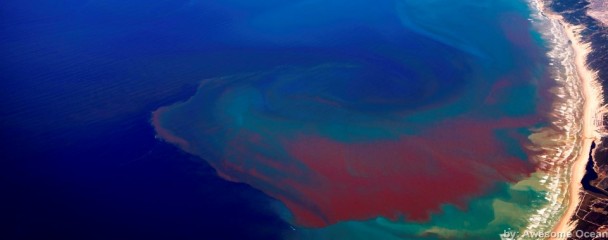Red Tide
Over the past few weeks there have been several reports of the presence of red tide in various locations along the South African coastline, in particular off Algoa Bay (Port Elizabeth) and more recently off Plettenberg Bay and Knysna. ‘Red tide’ is the common name for a phenomenon known as an algal bloom. Algal blooms are large concentrations of aquatic microorganisms, known as dinoflagellates, that can become so dense that the colour of the water appears red or brown. Algal blooms are caused by upwelling events which are brought on by a high prevalence of easterly winds along the south coast of South Africa. Upwelling brings cold water, and the dinoflagellate cells, into warmer surface waters. The combination of warmth and sunlight causes the cells to bloom. In most cases, these blooms are naturally occurring events and can occur each year if the conditions are favorable. Human induced activities, such as the production of agricultural run-off from farming practices, can intensify the strength of the bloom by introducing nitrates and phosphates into the water.
According to Dr Tommy Bornman from SAEON (South African Environmental Observation Network) the red tide we experienced at the beginning of 2014 was likely to return during the next and subsequent summer seasons (http://mype.co.za/new/red-tide-expected-to-re-occur/42721/2014/11). The dinoflagellate responsible for the algal bloom earlier this year was Lingulodinium polyedrum. L. polyedrum is an invasive species to South Africa (https://oceanadventures.co.za/alien-species/)and is normally only found in tropical and temperate northern hemisphere waters. It was most likely brought into South African waters during it’s resting phase, in the ballast waters of a foreign ship. It is possible that the cells of L. polyedrum have been dormant in our waters for some time awaiting the suitable sea conditions that cause it to bloom. This is exactly what happened in early 2014.
At present (November 2014) we are experiencing a bloom of the species Noctiluca miliaris, a different species of dinoflagellate, but one that is native to South African waters and normally blooms at this time of year. N.miliaris is non-toxic to humans and is responsible for producing the magical displays of bioluminescence that we can see in the bay. L. polyedrum has not yet bloomed, but the researchers at SAEON are conducting regular water test to monitor when it does. L. polyedrum can produce toxins that affect shellfish and therefore give humans shellfish poisoning. The reason shellfish (mussels, oysters, clams and scallops) are the most affected animals is because they are filter feeders, so when they eat (filter water) they accumulate the toxins in their bodyies. The toxin that L. polyedrum produces can also affect other marine life, but is not thought to be toxic enough to harm people while swimming.
So, be on the lookout for the magical light show that this red tide can produce and we will keep you posted as and when we hear more about the bloom along our coastline.





